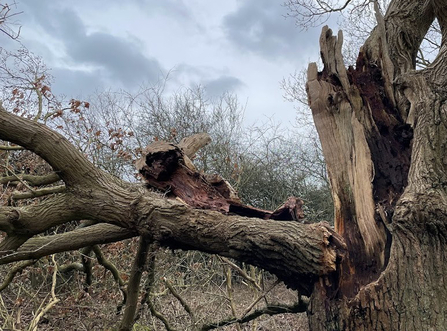Another month gone already and we're enjoying spring around the reserve. We're still finding damage from the winter storms, and whilst we do try to keep the path network and fences clear, if a tree is damaged away from the paths we leave it as it is. These dead or damaged trees then become a valuable resource for our insect populations, which in turn feed birds and mammals. The various holes and areas of rot provide nesting and roosting spots, and plants will take advantage of any material that is being broken down. There is nothing more alive than a dead tree! We found this blasted oak north of the railway and we think it looks fabulous.
Diary of the Whisby wardens: March 2024

Drainage has been a problem everywhere this winter, and whilst we need the ground to dry out a bit before we can do repairs to the path network there are areas where we can start the prep work. The Education Centre has really struggled with parts of the grounds becoming unusable due to the amount of water so we've put in a French drain to try to get the ground to drain in areas where access is needed. A French drain is a perforated pipe surrounded by chunky pebbles which lets the area drain more freely. When we started digging we found a pile of old timber which was probably in the way of natural drainage. When your site is an old quarry, you never know what you're going to uncover. In other areas across the reserve we've dug drainage channels and grips in an attempt to keep the paths clear, but with the amount of rain we are still getting sometimes it feels like we're chasing our tails!

Preparation work has also been underway over the past couple of months to clear some of the fence lines before the birds started nesting. Our wonderful volunteers have worked steadily through layers of bramble and willow to expose the broken posts so we can replace them over the spring months.
In Little Heath we've been trying to stop the bramble from spreading into the heathland where it would quickly shade out the more delicate and much rarer plants like heath bedstraw and heather. Bramble roots on long runners sent out by the parent plant so it can quickly come in from the fence lines to dominate an area. The sheep do most of the work for us when they graze the area in the winter (our sheep love to eat bramble and nettle and will seek them out even when there are far more appetising things around to munch on!) but they can't keep on top of it forever. To keep it in check we've been pulling bramble runners out of the heathland by their roots, digging it out with mattocks and trying to ensure we get as much of the root ball out as possible. Some of them were really impressive!

We've welcomed back chiffchaffs, blackcaps and willow warblers and started to see the cowslips bloom, so it really feels like spring is getting going. We've even spotted one or two grass snakes enjoying the sun between the showers so keep your eyes and ears open as you're out and about.


